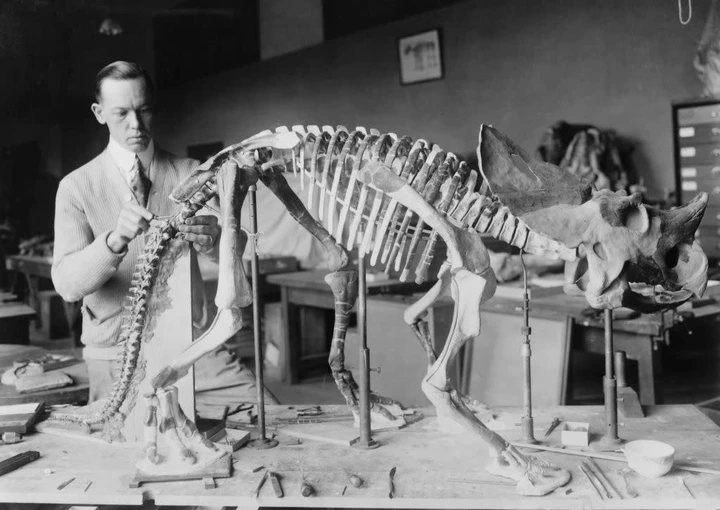
View pictures in App save up to 80% data.
A paleontological curator is working on the preparation of a baby dinosaur skeleton, dating back approximately seven to eight million years, for display. The fossil was discovered in Montana. The artist remains unidentified, and the work is from 1921. Credit - Pierce Archive LLC/Buyenlarge via Getty Images.
The slogan “Make America Great Again,” associated with the Trump campaign, conveys a desire to revert to a nostalgic vision of a time when America was perceived as better and more genuinely “American.” Although the idealized past championed by certain MAGA supporters may not accurately reflect historical realities, it resonates with anxieties surrounding the transformations instigated by decades of immigration and civil rights advancements that have fostered greater diversity and inclusivity in the nation. This isn’t the first instance in American history where notions of the past have been leveraged to shape the concept of national identity.
Interestingly, remnants of historical discussions surrounding American identity can be uncovered in unexpected locations: dinosaur museums. While dinosaurs themselves weren’t engaging in identity debates, the 19th-century Americans who established the initial dinosaur museums were very much involved in such dialogues. The discovery of these fossils revolutionized the way Americans perceived their own identity and contributed to the ongoing discourse regarding who has the right to identify as American.
The discovery of fossils in the 19th century indicated that the territory now known as the United States had a history that stretched far beyond earlier assumptions. This newfound awareness of "deep time" allowed the inhabitants of the New World to distinguish their identity in contrast to the established narratives of the Old World in Europe. Concurrently, those of European ancestry in America leveraged the concept of "deep time" to marginalize Indigenous peoples and African Americans from the narrative of American history, thus positioning white Americans of European descent as the central figures in this evolving story.
Additional Insights from TIME
Deep time refers to the vast expanse of time required for planetary and cosmic processes to develop. Consider that the universe has existed for approximately 14.5 billion years, while our Earth formed around 4.5 billion years ago, and the oldest surface rocks in North America date back nearly as far.
The idea of deep time emerged in the United States between the American Revolution and the invention of the automobile. It replaced the older idea that the Earth was only about 6,000 years old and that America was a new nation on a very young continent in the very New World. Many people at the time of the Revolution thought that the New World had risen last from the receding waters of the Flood that had ferried Noah’s Ark to safety. The Old World of Europe had risen earlier, allowing its climate to warm up nicely.
For Europeans, the unfamiliarity of the New World accounted for their perception that conditions in America were inferior to those in Europe. The damp climate of America was believed to cause all forms of life to diminish in size and strength, affecting plants, animals, and even humans. Take elephants, for example; they were thought to have evolved into smaller tapirs with short trunks and legs. As for the Indigenous populations, it was suggested that the lesser facial hair of Indigenous men compared to their European counterparts indicated a deficiency in masculinity that prevented them from growing beards.
In 1776, the American colonies proclaimed their independence from Britain, breaking free not only from British rule but also from the European notions of American inferiority.
In the coming hundred years, Americans developed a distinctive national identity rooted in the concept of time. In contrast to the aged and decaying monarchies of Europe, the United States emerged as a youthful and dynamic nation.
However, Americans quickly embraced a novel concept—that their nation was, in fact, ancient and profoundly established. Although their republic was recent, the territory it occupied was not just older than Europe; it was the oldest on the planet: God's initial creation, a pristine Eden designed as the backdrop for a magnificent national destiny.
In the early 1820s, the discovery of trilobites along the banks of the newly constructed Erie Canal provided compelling evidence for the ancient history of the land. These peculiar fossils, resembling horseshoe crabs and found deeply embedded in the rock layers, sparked curiosity among America’s first professional geologists. Although precise dating methods for fossils and rocks would not emerge until the advent of radiometric dating in the early 20th century, the significant depth at which the trilobites were located indicated that they were likely remnants of some of the earliest life forms on our planet.
The geologists came to understand that this was not the well-known garden from Genesis, but rather a submerged paradise—possibly the original ocean created by God, teeming with life and home to the earliest beings, the humble trilobites.
Americans sent trilobite fossils to European researchers who had discovered comparable specimens. The industrial revolution prompted both Americans and Europeans to excavate the Earth extensively in search of the ores and minerals essential for modern industries, particularly coal mining. However, this extensive digging also ignited a transformative shift in understanding the planet's age. With scientists from both sides of the Atlantic uncovering trilobites within the same geological layers, the notion of superiority in age became obsolete. American scientists reveled in the newfound evidence suggesting that America was as ancient as Europe—perhaps even older.
As the 19th century unfolded, the concept of time took on new dimensions for Americans venturing westward. White plantation owners migrating into areas like Alabama, Mississippi, and Louisiana—known as the “Cotton Kingdom”—were on a quest for fertile land. To aid in their search, they enlisted geologists who meticulously examined rivers and plantations in pursuit of the richest soils. In their explorations, they stumbled upon fossils of ancient sea creatures such as Mosasaurus, the fearsome predator of the primordial oceans. The geologists proclaimed that the South’s abundant fertility was rooted in its dark, Cretaceous (meaning “chalky”) soils.
In the years leading up to the Civil War, white Americans developed a harmful form of "science" centered around the rich black-belt soil of the Cotton Kingdom. They believed that long ago, God had fashioned a vibrant ocean filled with beings such as the Mosasaurus. As this ocean receded, its inhabitants died off, leaving behind fossilized remains that contributed to the fertile, chalky lands of the South.
Certain white Americans linked the supposed inferiority of Black individuals to the rich black-belt soils of the South. They believed that, beyond simply equipping the American South for slavery with its fertile land, God had also fashioned Black people with the skin color best suited for laboring on that soil. “Only blacks can cultivate the fertile lowlands of this region,” remarked a geologist in 1844 during his exploration of the South. This understanding of geological history further solidified racial hierarchies within the United States.
Following the Civil War, white Americans ventured further into the Nebraska territory, crafting a fresh American identity rooted in the concept of deep time. As they excavated the earth to lay down railroad tracks, they unearthed massive, formidable dinosaur bones, which they named Brontosaurus (meaning thunder lizard) and Tyrannosaurus Rex (translating to tyrant lizard king).
Western geologists observed that with the extinction of certain dinosaurs in the fossil record, a fresh array of fossils emerged above them: mammals. This era, marked by the rise of mammals, was aptly named the Eocene, signifying the beginning of a new age. Among the new life forms that emerged was Eohippus, a small “dawn horse” that roamed the early grasslands of America.
The narrative constructed by white scientists regarding the earliest mammals illustrated the ways in which deep time could be used to marginalize certain groups. According to these scientists, the original inhabitants of America were not the Sioux or other Indigenous peoples.
Long ago, millions of years in the past, the rich soil of America birthed incredible beings such as Eohippus. Over time, these small equines journeyed to Asia, where they evolved into larger forms, sharing the robust spirit of American life with the globe. As humans rode these majestic animals, civilizations flourished from the vast steppes of Asia to the ancient realms of Greece, Rome, and beyond into Europe. Following the year 1492, the Spanish Conquistadors returned the horse to its homeland: America.
In this narrative, neither the Sioux nor the Spaniards can claim the title of the first Americans. The true pioneers of America were the mammals of the Eocene epoch. Prior to them, the land was inhabited by the earliest reptiles, the dinosaurs. Even before that, the initial life forms were the trilobites.

View pictures in App save up to 80% data.
The essence of the narrative was that Native Americans held no greater legitimacy as true Americans than their white counterparts. This perspective was voiced by some of the earliest dinosaur hunters in the Western United States. The vast timeline of deep time incorporated trilobites, dinosaurs, and the earliest mammals into the history of the nation. In contrast to this immense and captivating temporal framework, the importance of American Indians diminished. They ceased to be recognized as the original Americans.
The next time you marvel at the enormous fossils displayed in a dinosaur museum, keep in mind that you’re also peering into a chapter of U.S. history and the ongoing discussion about what it truly means to be American.
Write to Made by History at [email protected].
 Top-rated Choice
Top-rated Choice